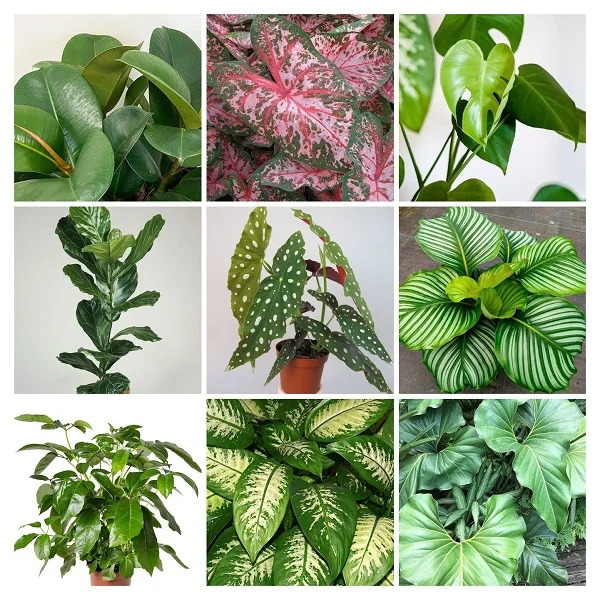10 Types of Senecio Succulent Types with Names and Pictures
Some links in this post may be affiliate links
Senecio Plants are flowering plants which are mostly native to Africa and have interesting leaf shapes and colors as an adaptation to dry conditions.
There are about 1200 species in the Senecio genus of the daisy family, Asteraceae, of which about 100 species are succulent plants. The plants vary a lot in structure and growth habits. They may be annuals, biennials, perennials, climbers, shrubs and so on.
The flowers in Senecio Succulents are clusters of daisy-like flowers with ray florets arranged in a circle and may be white, yellow, pink, purple or any color in-between.
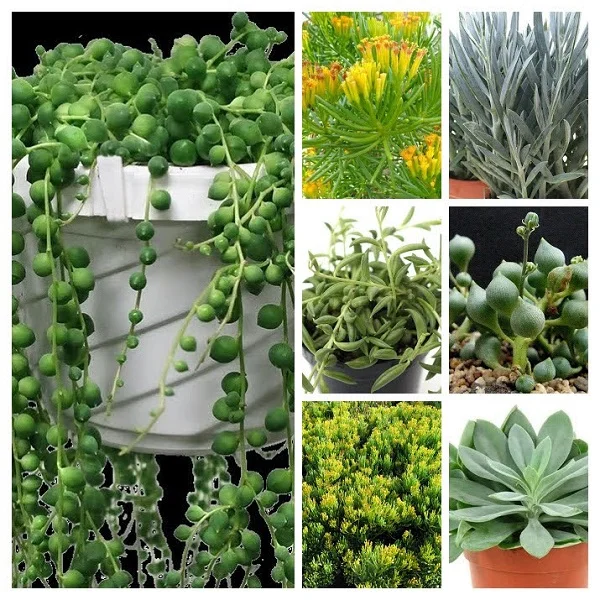
The genus name, 'Senecio', is Latin for 'Old Man', in reference to the hairy structures on the seeds. Recently some 20 Senecio species have been seperated to the Curio genus based on their similarities. Curio is Latin for 'Curious'.
Some of the Senecio Plants which have been placed in the Curio genus include String of Lemons Plant, String of Tears, String of Beads, Blue Chalksticks Plant among others.
It is important to note that Senecio Varieties are considered toxic to both humans and pets. According to The American Society for the Prevention of Cruelty to Animals, Senecio plants contain Pyrrolizidine alkaloids which if is ingested, can cause drooling, vomiting, diarrhea and lethargy.
Contact with the plant sap may cause skin irritation or skin rash in sensitive skin. Therefore, always wear gloves when handling these plants and keep them away from the reach of children and pets.
Senecio varieties are easy to grow when given the right growing conditions. Generally, these plants require bright light with some direct sunlight, well-drained and moderately moist, rich soil, average warmth and moderate humidity.
10 Senecio Succulent Types for Indoors
The best Senecio varieties are Senecio mikanioides, Senecio angulatus, Senecio barbertonicus, Senecio citriformis, Senecio herreanus, Senecio peregrinus, Senecio cephalophorus among others.
1. German Ivy (Senecio mikanioides)
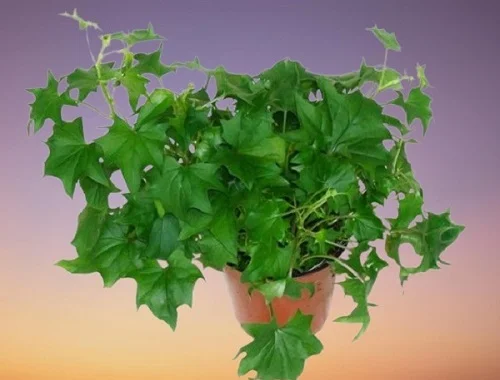
German Ivy also called Cape Ivy or Parlour Ivy is not a True Ivy. It is more vigorous and is less affected by warm and dry conditions than a true ivy.
The leaf lobes in German Ivy are fleshier and generally more pointed and the leaves have several pointed lobes. The stems can be allowed to trail in a hanging basket or are trained to grow up canes or trellis. Parlour Ivy is one of the best plants for hanging baskets.
German Ivy flourishes in medium to bright light, warmth of 18-270C, humidity of 50-55% and moderately moist, fertile, well-drained succulents potting soils coupled with fortnightly feeding during the growing season.
Learn more on how to grow and care for German Ivy.
2. Scrambling Groundsel (Senecio angulatus)

Scrambling Groundsel also called Climbing Groundsel, Creeping Groundsel or Algerian Senecio is an easy-care, scrambling and twining, succulent, shrubby plant whose leaf lobes are fleshy, glossy green, pointed, coarsely-toothed with 3-5 teeth on each side.
The leaves in Climbing Groundsel are alternately arranged and about 8 inches long by 5.5 inches wide. The veining stems can trail up to 6.6 feet which makes this plant one of the best succulents for a hanging basket.
Senecio angulatus thrives in medium to bright light, warmth of 18-280C, humidity of 50-55% and moderately moist, rich, well-drained succulents potting soil coupled with monthly feeding in spring and summer.
Learn more on how to grow and care for Scrambling Groundsel.
3. Barberton Groundsel (Senecio barbertonicus)

Barberton Groundsel also called Succulent Bush Senecio or Barberton Senecio is perennial, succulent plant densely packed with lime-green, finger-like, fleshy leaves on fleshy stems and a cluster of tufted terminal flowerheads of golden-yellow, tubular-shaped and sweetly scented flowers.
Succulent Bush Senecio can grow to a height of 6 feet by 6 feet wide but when grown indoors which places it is among the best tree-like plants for the home.
Senecio barbertonicus blossoms in bright light with 4-6 hours of direct sunshine, warmth of 20-260C, humidity of 50-55% and moderately moist, rich, well-drained succulents soils coupled with regular feeding in the growing season.
Learn more on how to grow and care for Barberton Groundsel.
4. Mountain Fire Senecio (Senecio cephalophorus)

Mountain Fire Senecio is a compact plant which bears a rosette of paddle-shaped, grey-green leaves on branching stems.
The bloom is a large head of dark-orange inflorescence borne above the foliage on a long stalk. The species name, 'cephalophorus', is Latin for 'head-bearing', in reference to the inflorescence. Mountain Fire Senecio is one of the best flowering plants for indoor growing.
Senecio cephalophorus prospers in bright light with 4-6 hours of direct sunshine, warmth of 20-260C, humidity of 50-55% and moderately moist, fertile, free-draining succulents mix coupled with monthly feeding during the growing season.
Learn more on how to grow and care for Mountain Fire Senecio.
5. String of Lemons Plant (Senecio citriformis)
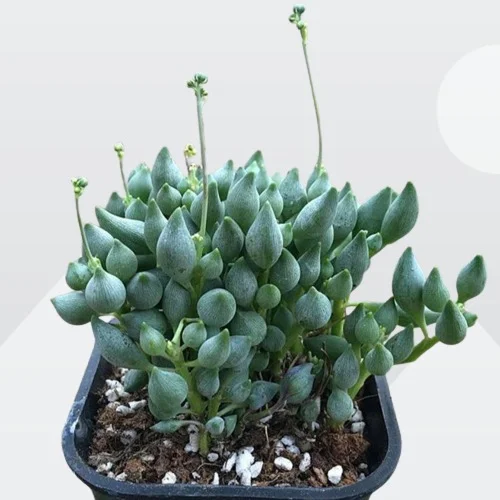
String of Lemons Plant also called String of Tears Plant or String of Teardrops Plant bears erect stems on which grow oval, teardrop-shaped or lemon-shaped, green to dark-green leaves with translucent longitudinal stripes (windows).
On account of its compact size, drought tolerance and requirement for bright light with exposure to some direct sunshine, String of Teardrops Plant is one of best low-maintenance plants for a sunny balcony.
Senecio citriformis performs best in bright light with 4-6 hours of direct sunlight, warmth of 20-270C, humidity of 50-55% and moderately moist, fertile, well-drained succulents soils coupled with monthly feeding in spring and summer.
Learn more on how to grow and care for String of Lemons Plant.
6. String of Watermelons Plant (Senecio herreanus)
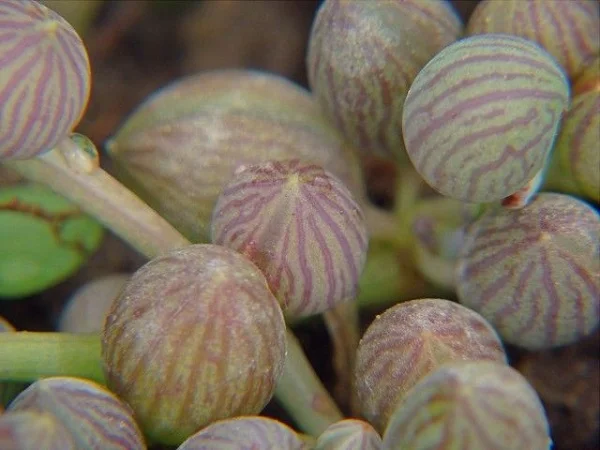
String of Watermelons Plant is also called String of Raindrops Plant or Gooseberryplant bears pendant thread-like stems on which grow succulent, oval-shaped, dark-green leaves with purple stripes and resemble the rind of the watermelon fruit and hence the common name.
On account of its drought tolerance and requirement for bright light with exposure to some direct sunshine, String of Raindrops Plant is one of best sun-loving plants for the home.
Senecio herreanus thrives in bright light with 4-6 hours of direct sunshine, warmth of 20-270C, humidity of 50-55% and moderately moist, fertile, well-drained succulents potting mix coupled with monthly feeding in the growing season.
Learn more on how to grow and care for String of Watermelons Plant.
7. String of Dolphins Plant (Senecio peregrinus)

String of Dolphins Plant also called Dolphin Necklace, Flying Dolphins or Dolphin Plant bears pendant thread-like stems on which grow curvy leaves with two small points and like a pod of flying or jumping dolphins and hence the common name.
The pendant stems in Dolphin Necklace make it perfect for a hanging basket, a pedestal, a tabletop, a desktop or a shelf where the stems can beautifully cascade downwards. It is among the popular string of plants for indoors.
Senecio peregrinus blossoms in bright light with 4-6 hours of direct sunlight, warmth of 20-270C, humidity of 50-55% and moderately moist, fertile, well-drained succulents potting soils coupled with monthly feeding during the growing season.
8. String of Bananas Plant (Senecio radicans)
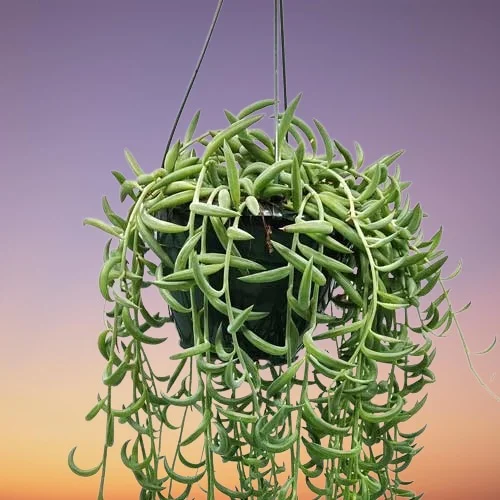
String of Bananas Plant also called String of Fishhooks Plant or Fishhooks Senecio is a unique plant which bears pendant thread-like stems on which are tiny leaves shaped like small green bananas.
On account of its drought tolerance and requirement for bright light with exposure to some direct sunshine, String of Bananas Plant is one of best succulent plants for full sun conditions.
Senecio radicans thrives in bright light with 6-8 hours of direct sunlight, warmth of 20-270C, humidity of 50-55% and moderately moist, rich, well drained succulents potting soil coupled with monthly feeding in spring and summer.
Learn more on how to grow and care for String of Bananas Plant.
9. String of Pearls Plant (Senecio rowleyanus)
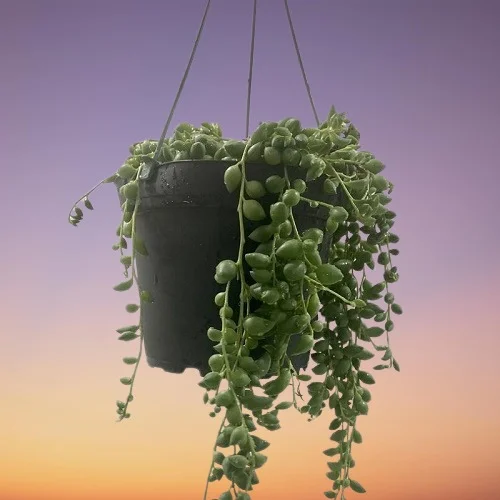
String of Pearls Plant or String of Beads Plant is a unique plant which bears pendant thread-like stems on which spherical green leaves grow and resembles a neck-lace of beads or pearls making it ideal for a hanging basket, pedestal, tabletop, desktop or plant shelf.
On account of its low maintenance, versatility and eye-catching foliage, String of Beads Plant is among the most popular plants for the home. It is almost certain to find at least one in most homes.
Senecio rowleyanus flourishes in bright light with 6-8 hours of direct sunlight, warmth of 20-270C, humidity of 50-55% and moderately moist, fertile, well-drained succulents potting soil coupled with monthly feeding in the growing season.
Learn more on how to grow and care for String of Pearls Plant.
10. Blue Chalksticks Plant (Senecio serpens)

Blue Chalksticks Plant also called Dead Man's Fingers is one of the low-growing plants with fleshy, cylindrical, powdery, blue-green leaves on stems which start off erect then lie prostrate and root at the nodes as they grow.
The odd shaped leaves is an adaptation to arid conditions and allows for the storage of water while exposing minimum surface area to the dry air. This allows the plant to go for a considerably long period without being watered which places Dead Man's Fingers Plant among the best drought-tolerant plants for the home.
Senecio serpens requires bright light with 4-6 hours of direct sunlight, warmth of 20-270C, humidity of 50-55% and moderately moist, loose, rich, well-drained succulents soil coupled with monthly feeding in spring and summer.
Learn more on how to grow and care for Blue Chalksticks Plant.


